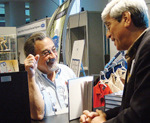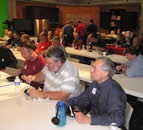News & Headlines
SBE at PBS TechCon 2019
 ATSC 3.0 and the rapid launch of NextGen Broadcast are the drivers behind the first-ever SBE/PBS TechCon collaborative tutorial day, which takes place Saturday, April 6, 2019 at PBS TechCon, held at the Flamingo Las Vegas Hotel. Open to anyone eager to learn what ATSC 3.0 means for the future of broadcast, the tutorial takes place the day after TechCon, is affordable ($95 for SBE and PBS members), and open to all. Online registration is now closed for this. However, a limited amount of walk-ins will be taken. Please see Education Director Cathy Orosz at the registration desk on April 6.
ATSC 3.0 and the rapid launch of NextGen Broadcast are the drivers behind the first-ever SBE/PBS TechCon collaborative tutorial day, which takes place Saturday, April 6, 2019 at PBS TechCon, held at the Flamingo Las Vegas Hotel. Open to anyone eager to learn what ATSC 3.0 means for the future of broadcast, the tutorial takes place the day after TechCon, is affordable ($95 for SBE and PBS members), and open to all. Online registration is now closed for this. However, a limited amount of walk-ins will be taken. Please see Education Director Cathy Orosz at the registration desk on April 6.
Following is a rundown of the day's topics and presentations. Additional session details will be added as they are announced.
SBE at PBS TechCon is supported by these companies, many of which are SBE sustaining members.
Launching NextGen Broadcast: An SBE Tutorial at PBS TechCon 2019
Section 1: 3.0 PHY
The fundamentals of transmission change dramatically compared to 8-VSB or any other more traditional broadcast modulation scheme. Originally, this alone was the motivation for replacing ATSC 1.0. It is the Physical Layer (PHY) that enables Single Frequency Networks and mobile reception. Beyond OFDM, a “bootstrap” signal and Physical Layer Pipes (PLPs) empowers NextGen (NGBT) over-the-air (OTA) TV to reach receiving devices in an extremely broad set of circumstances and for a multiple of uses.
Presenters:
Madeleine Noland, LG Electronics; ATSC Standard
Luke Fay, Sony; Physical Layer
Bill Soreth, Acrodyne Services; RF Planning SFN Design
Section 2: Regulations
Next Gen regulatory and contractual deployment requirements. These include simulcasting carriage mandates, program hosting agreement issues for 1.0 and 3.0 stations, government applications and notifications. Meeting these obligations and preserving station cashflow require that broadcast engineers have a good handle on how far ATSC 1.0 content compression can be pushed and at what cost. It’s valuable to have a firm grasp of video quality measurements. Partnering through channel sharing is a big part of broadcasters’ deployment plans. It’s a broadcast engineer’s role to fill in the technical specifications competently in each of these legal arrangements.
Presenter:
Jerry Fritz, ONE Media; NextGen regulatory and contractual deployment requirements
Section 3: Compression and Video Quality Measurements
Compression is critical to the transition to ATSC 3.0 in several ways. Improving MPEG IV compression (necessary for ATSC 1.0/8VSB legacy transmission) allows more services to be accommodated on a given “1.0 Host” channel share. One Media Labs performed a study on the progression of Video Quality encoding efficiency gains from legacy encoders to current software based encoding servers. This exhaustive study also has real time graphs of a current encoding platform in ten different statmux scenarios showing each video stream’s DMOS (Differential Mean Opinion Score) allowing engineers to objectively study how different generations of content with different resolutions interact in a multiplexed transport stream.
Presenters:
Marshall Behrmann, ONE Media; Compression
Adam Schadle, Video Clarity; Video Clarity
Tanisia Wright, ONE Media; AVC as an option
Section 4: Transmitter Conversion
Converting transmitters to 3.0 service and performing the proof-of-performance and acceptance testing will be covered by the engineers that build the transmitters. Further, some studio transmitter links (STL) can be reutilized or upgraded, while others cannot. While most stations will start with converting a “big-stick,” many will be looking at extending their coverage and increasing their penetration with the additional boosters that OFDM enables in a way that no other modulation previously used in broadcasting has.
Presenters:
Doug Lung, Telemundo Group, Inc; Basics and Intro
Joe Seccia, GatesAir Transmitters; GatesAir Transmitters
Greg Martin, Rohde & Schwarz; Rohde & Schwarz
Tom Barbeau, Comark Communications; Comark Transmitters
John Schadler, Dielectric; Dielectric
S. Merrill Weiss, Merrill Weiss Group; STLs
Vladimir Anishchenko, Avateq Corp.; Technical Features of the AVQ1022
Section 5: Platform
The most basic configuration for a new ATSC 3.0 station is simply distributing existing linear video broadcast content in the clear. To take advantage of NextGen’s potential, the quality of the video can go beyond HD and we can do more complex, more OTT like distribution. As NextGen moves forward, the Platform becomes a larger piece of the equation. First, it simply allows either internet or OTA delivery. Fully developed, it has the potential to be the dominant piece of NextGen TV, providing the NextGen user experience.
Presenters:
Jim DeChant, News-Press & Gazette Broadcasting; Platform
Greg Jarvis, Fincons Group; Hybrid Services - OTA/OTT
Azita Manson, OpenZnet; Advanced Advertising
Mark Corl, Triveni Digital, Inc.; Advanced Emergency Alerting
Steve Calzone, DTV Consulting; MVPD Integration with ATSC 3.0
Section 6: Scheduler
The Gateway, System Scheduler and Manager is the central piece of a NextGen broadcast transmission system. It aggregates all the IP content and assigns these to the proper Physical Layer pipes (PLPs), adding low-level signaling, control, announcement and configuration information that becomes the studio transmitter link (STL) stream that in turn feeds the modulator/exciter of the over-the-air (OTA) transmitter.
Presenters:
Ian Hoots, ONE Media; Gateway, System Scheduler, and Manager
Jerome Floch, Enensys; Scheduler workflow, ATSC profile selection, STLTP configuration
Sang Jin Yoon, DigiCAP Co., Ltd.; Scheduler workflow, ATSC profile selection, STLTP configuration
Junghoon Kim, DigiCAP Co., Ltd.; Scheduler workflow, ATSC profile selection, STLTP configuration
Section 7: Monitoring and Display
It might seem simple, and certainly we’ll look back at this moment in time with some humor and grace, but right now it’s not that easy to see that you are on the air with your recently converted ATSC 3.0 transmitter. Your first piece of NextGen test gear might be a dongle with an array of analytical and decoding/player/display software. You not have to throw out your current TV. The first home gateways with very limited capability and storage are entering the prototype stage. Mobile devices seem further out, though chipsets are becoming available and 5G/3.0 convergence would seem to drive this market.
Presenters:
Myra Moore, Digital Tech Consulting; Introduction
Bonnie Beeman, Airwavz.tv; TvXplorer Demo
John Casey, Airwavz.tv; Monitoring and Display
Ralph Bachofen, Triveni Digital Inc.; Streamscope Demo
Joonyoung Park, DigiCAP Co., Ltd.; DigiCAP Home Gateway Demo
Jason Justman, Sinclair Digital
Section 8: NextGen Station
The first effort will focus on transmitting current content on ATSC 3.0. The DAI provides new sales opportunities. An additional transmission system will be monitored in master control. Digital and linear workflows meld. AEI (informing) becomes important for processing, validating, curating, and archiving information then distributing it on platforms that now include AEI receiver apps.
Presenter:
Winston Caldwell, Fox Networks Group; Triggers SCTE/IAB Vast, Workflow, Traffic systems/monetization, Security
Section 9: Future
Finally, we’ll address some of the issues of adoption, timing, budgeting, project planning and looking further out, the enhanced content and services that NextGen Broadcasting is designed to liberate. There will be fear, uncertainty, misinformation and dread. We’ll conclude with what is real and what is not, matching adoption curves with equipment life cycles. We will separate what happens today and what happens further down the road. In particular, what changes in broadcast station architecture and workflow as digital ad insertion and ad tech move the revenue needle.
Presenters:
Chris Gordon, Imagine Communications; Advaced Advertising
Mark Aitken, Sinclair Broadcast Group and ONE Media; Homogeneous networks
The SBE at PBS TechCon is organized by
Fred Baumgartner, CPBE, CBNT
Go to the News and Headlines Archive
















